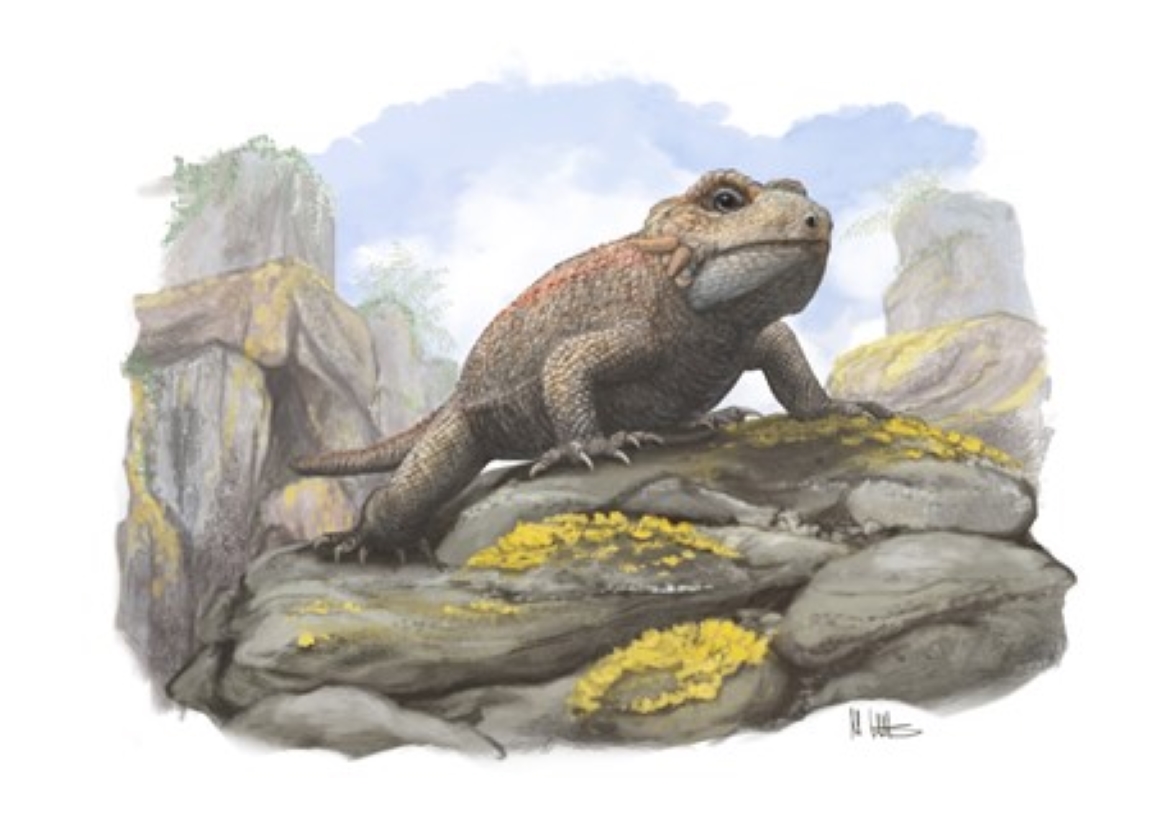The fossilised lizard was found in Cromhall Quarry, southwest England

Reconstruction of new species Threordatoth chasmatos © palaeoartist Mark Witton
- Scientists have described a new species of procolophonid reptile
- The fossilised lizard was found in Cromhall Quarry, southwest England
- The new species is notable for its unusual dental adaptations
A fossil hotspot in southern England has revealed another of its secrets. The former quarry located in Cromhall, South Gloucestershire, is renowned as a rich source of Triassic wildlife. Gliding reptiles, dinosaur relatives and even one of the earliest known lizards have all been found at the site over the past few decades. Now, scientists have described a new species of procolophonid reptile notable for its unusual dental apparatus and jaw mechanics.
The remains of Threordatoth chasmatos, some of which are now cared for as part of the Natural History Museum collection, were recovered from ancient fissure fills, often described as ‘time capsules’ which had preserved fragments of skulls and jaws, offering insight into the anatomy of Threordatoth. The discovery offers a glimpse into the Carnian–Norian age of the Late Triassic, roughly 220–210 million years ago allowing the researchers to reconstruct ecosystems from a period when early dinosaurs were emerging as dominant land animals.
‘This small reptile’s teeth and jaw show features we’ve never seen before in its group,’ said lead author Dr Luke Meade, fellow at the University of Birmingham.
‘It likely fed in a way that distinguished it from its closest relatives, which opens up new questions about how these animals were interacting with their environment during the Late Triassic period.’
The teeth of Threordatoth chasmatos set it apart from other procolophonids, a group of extinct, small-bodied reptiles. Its upper jaw features tricuspid teeth—each with three distinct points—while the lower jaw bears compressed monocuspid teeth with an unusual edentulous (toothless) tip. These adaptations may have facilitated a distinct method of food processing.
‘Inferring the interplay between the upper and lower teeth is fascinating, there are several aspects of the tooth shape that resemble those of mammals’ explained Dr Marc Jones, Fossil reptiles Curator at Natural History Museum London.
‘The lower jaws were not fused at the chin, instead the connection was held with soft-tissue and likely flexible. This flexibility might have allowed the lower jaws to meet in a way that would help chewing food. This feature isn’t seen in closely related species and might indicate a specialized diet or feeding strategy.’
The Late Triassic was a time of dramatic environmental change, as the supercontinent Pangaea began to break apart. The peculiar dental adaptations of Threordatoth chasmatos suggest it may have been exploiting a unique ecological niche in a changing climate, feeding on plants, insects, or other small prey that required specialized oral food processing.
Dr Marc Jones concluded, 'Threordatoth chasmatos lived at a time when Solar irradiance was significantly lower than today but atmospheric CO2 was significantly greater. Overall, it was hotter, average global sea level was higher, and there were extreme rainfall events. Therefore, Threordatoth chasmatos and the community in which it lived could potentially provide perspectives for todays’ threatened ecosystems and the planetary emergency we face.’
The Natural History Museum has nine research themes helping to find solutions to some of the biggest global challenges. From tackling climate change and meeting the mineral needs of a net zero world to restoring biodiversity and achieving food security, our collections offer insight into how we create a brighter future for both people and the planet.
The paper A new procolophonid with complex dentition from the Late Triassic of southwest England is published in the journal Papers in Palaeontology.
Notes to editors
Assets
Images are available here.
Press Contact
Natural History Museum Press Office
Tel: +44 (0)20 7942 5654 / 07799690151
Email: press@nhm.ac.uk
The Natural History Museum is a world-leading science centre and one of the most visited attractions in the UK. A global source of curiosity, inspiration and joy.
Our vision is to build a future in which both people and the planet thrive.
We aim to be a catalyst for change, engaging advocates for the planet in everything that we do.
Our 350 scientists are finding solutions to the planetary emergency in all aspects of life. Visit, join and support the Natural History Museum today. Protecting the planet. It's in our nature.
Don't miss a thing
Receive email updates about our news, science, exhibitions, events, products, services and fundraising activities. We may occasionally include third-party content from our corporate partners and other museums. We will not share your personal details with these third parties. You must be over the age of 13. Privacy notice.
Follow us on social media